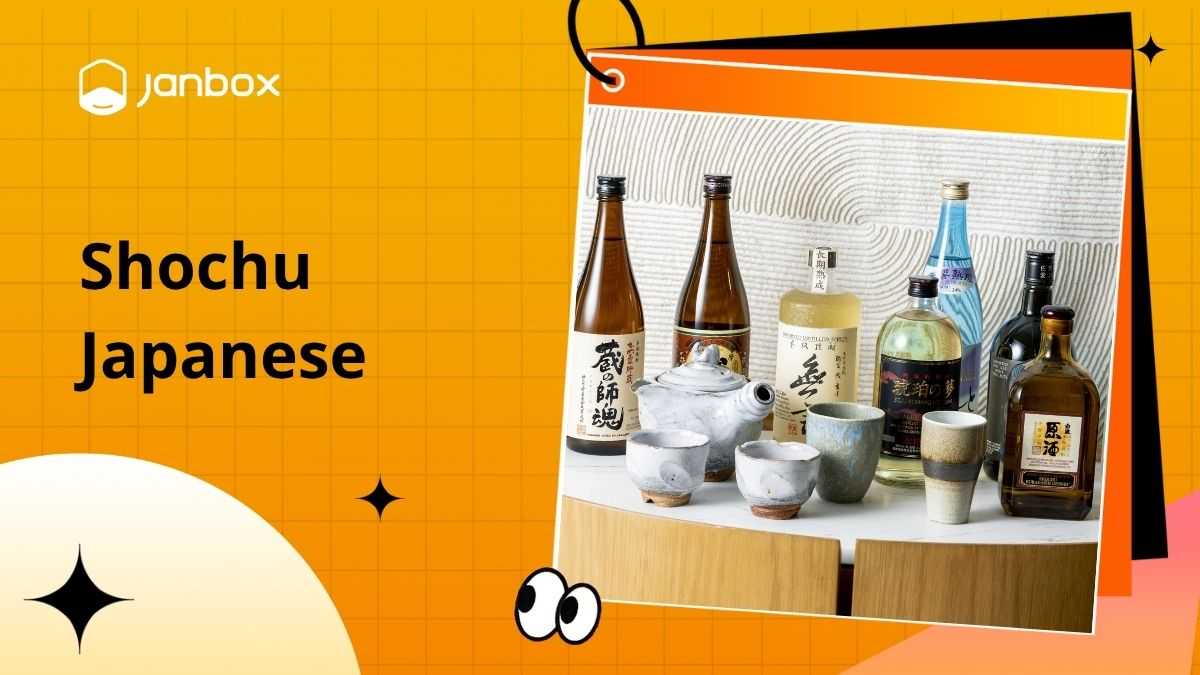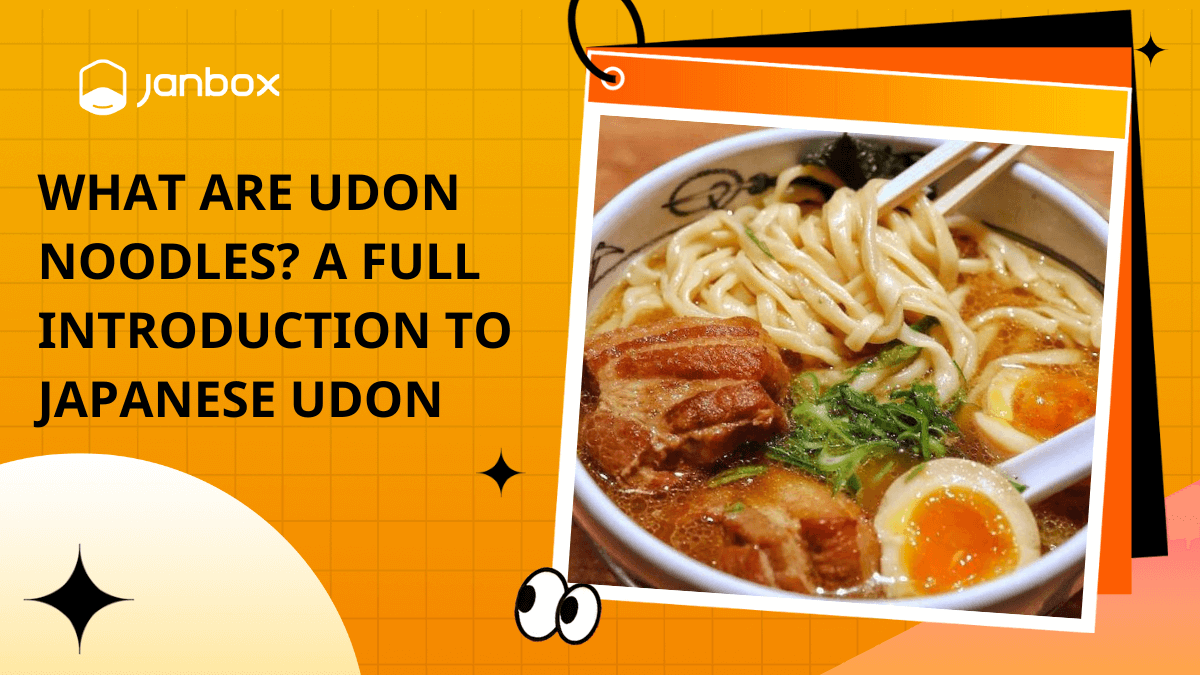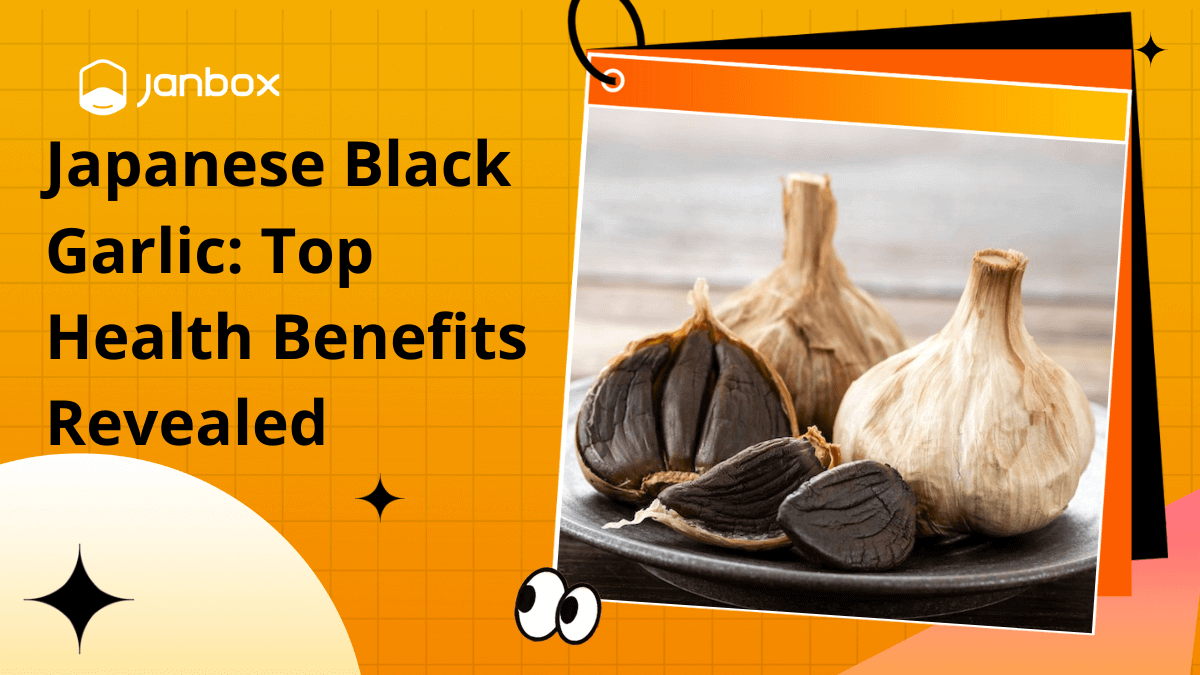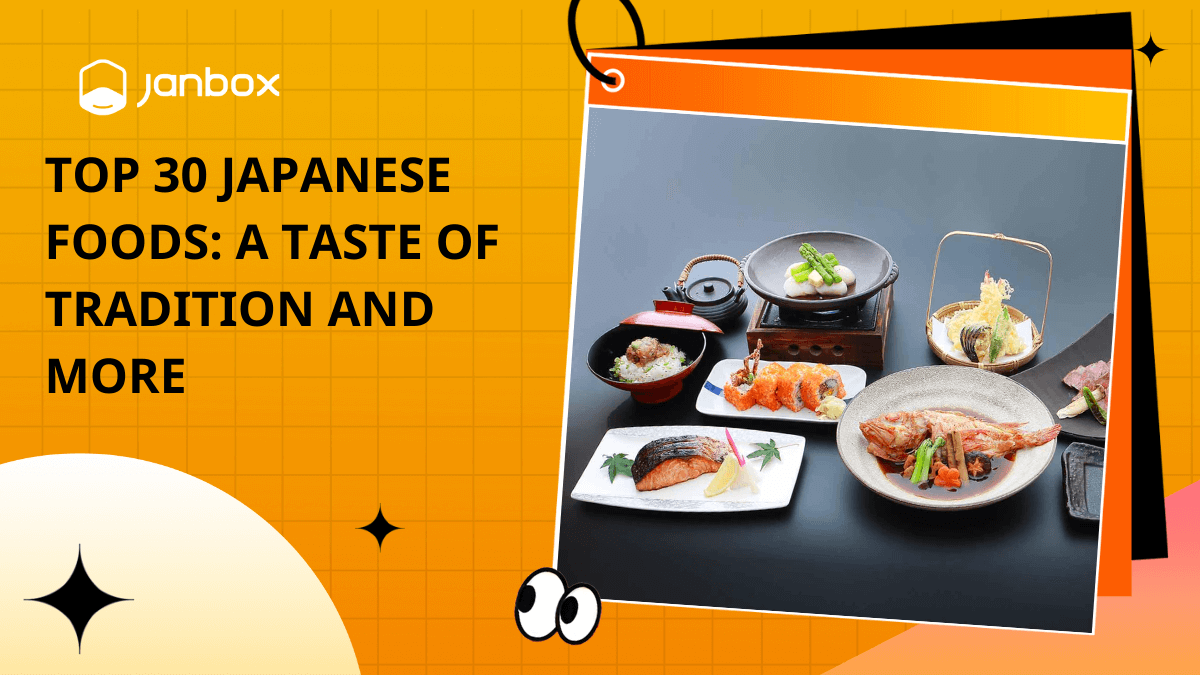Often mistakenly referred to as “shochu Japanese wine” by those unfamiliar with its unique characteristics, shochu Japanese is in fact a distilled spirit, distinct from sake (rice wine) and traditional wines. This versatile beverage holds a deep-rooted place in Japanese culture, boasting a rich history and a diverse range of flavors. Far from a simple wine, shochu offers a captivating journey into Japan’s intricate world of distilled alcoholic beverages.
This comprehensive guide will demystify shochu, exploring its origins, diverse types, intricate production methods, and how it stands apart from other global spirits. You’ll also learn the best ways to enjoy it, discover perfect food pairings, and find out where to buy authentic shochu Japanese for your own exploration.
1. What is Shochu?
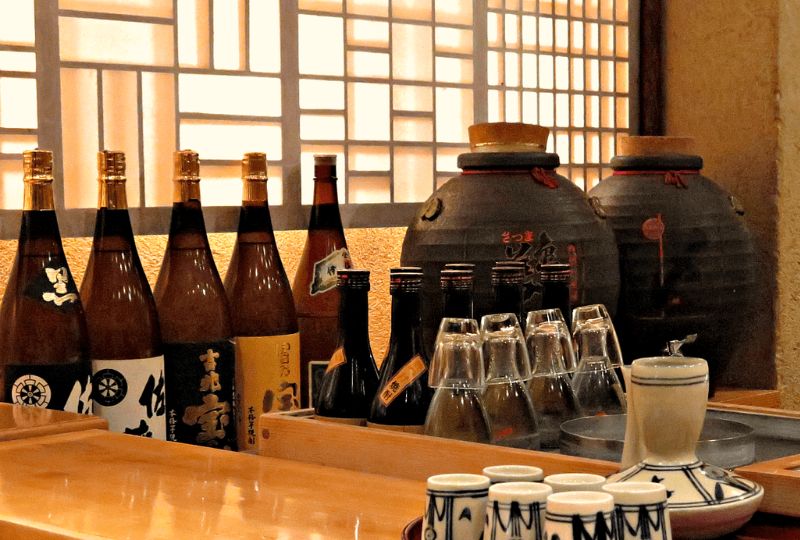
Shochu Japanese is a traditional Japanese distilled alcoholic beverage, typically made from a variety of ingredients such as rice, barley, sweet potato, buckwheat, or brown sugar. Unlike sake, which is fermented (like wine or beer), shochu undergoes a distillation process, resulting in a higher alcohol content and a purer, often more robust, flavor profile. Its alcohol by volume (ABV) usually ranges from 20% to 45%, with the most common varieties being around 25%.
The misconception of “shochu Japanese wine” likely stems from its origin country and alcoholic nature, but it’s crucial to understand that shochu belongs to the family of spirits, similar to vodka, whisky, or gin, rather than wine.
2. Cultural and Historical Significance
The history of shochu Japanese is as rich and complex as its flavors. Its origins can be traced back to the 15th century, with distillation techniques believed to have arrived in Japan from mainland Asia, possibly via Okinawa (where Awamori, a precursor to shochu, developed) or Kyushu.
- The oldest confirmed record of shochu dates back to 1559. A graffiti found on a pillar at Kōriyama Hachiman Shrine in Ōkuchi, Kagoshima Prefecture, mentions a brewer offering shochu to the deity.
- Shochu production flourished in southern Japan, particularly in Kyushu (Kagoshima and Miyazaki prefectures) and Okinawa, where local ingredients like sweet potatoes and black koji mold were readily available. These regions became the heartlands of shochu culture.
- While sake held a more prestigious image for centuries, shochu gained significant popularity, especially after World War II, due to its affordability and versatility. By the 1980s, it experienced a massive boom, becoming a staple in izakayas (Japanese pubs) and homes across the country.
- Today, shochu is deeply ingrained in Japanese daily life and gastronomy. Its diverse expressions reflect regional identities, making it a proud symbol of Japan’s rich drinking culture.
3. Types of Shochu
The world of shochu Japanese is incredibly diverse, primarily categorized by its base ingredient and distillation method.
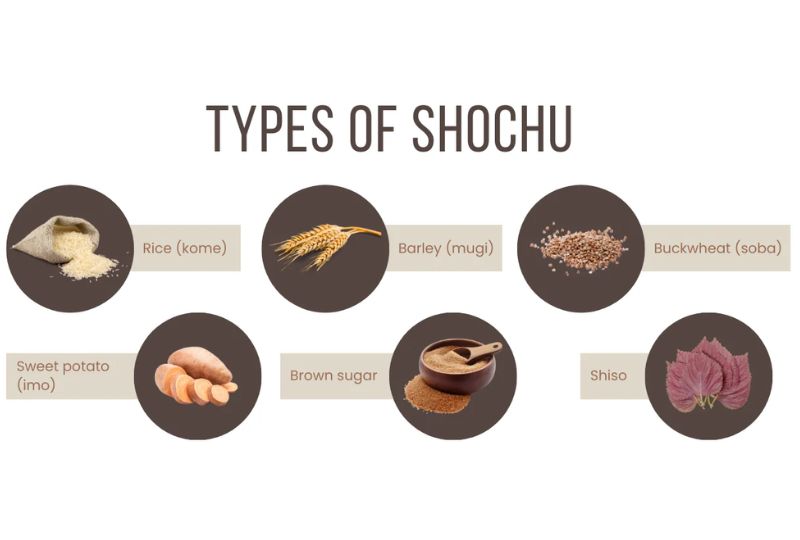
By Base Ingredient:
- Imo Shochu (芋焼酎 – Sweet Potato Shochu): Predominantly from Kagoshima and Miyazaki. Known for its distinct, often earthy or slightly smoky aroma, and rich, sweet flavor. It can be quite aromatic and bold.
- Mugi Shochu (麦焼酎 – Barley Shochu): Popular in Oita and Nagasaki. Typically lighter, smoother, and easier to drink than imo shochu, with a subtle grainy aroma. It’s often chosen by shochu beginners.
- Kome Shochu (米焼酎 – Rice Shochu): Mainly from Kumamoto (Kuma Shochu is famous). It has a very clean, mild, and slightly sweet flavor, often reminiscent of sake but with a distilled purity.
- Kurozato Shochu (黒糖焼酎 – Brown Sugar Shochu): Exclusively made in the Amami Islands of Kagoshima. Unique for using brown sugar, yet it’s surprisingly not sweet due to distillation. It offers a mellow flavor with a hint of tropical aroma.
- Soba Shochu (蕎麦焼酎 – Buckwheat Shochu): Made from buckwheat, often found in Miyazaki. It has a mild, slightly nutty flavor and a smooth finish.
- Awamori (泡盛): A unique Okinawan spirit, technically a type of rice shochu made exclusively from Indica rice using black koji mold, and often aged. It has a distinct robust flavor profile.
By Distillation Method:
- Honkaku Shochu (本格焼酎 – Single-Distilled Shochu): This is the traditional, higher-quality type. It’s distilled only once, preserving the natural flavors and aromas of the base ingredients. This is what most shochu connoisseurs seek.
- Kōrui Shochu (甲類焼酎 – Multiple-Distilled Shochu): Distilled multiple times, resulting in a very pure, neutral, and odorless spirit, similar to vodka. It’s often used as a base for chuhai (shochu highball) or fruit liqueurs, or for cooking. Its ABV is typically higher (up to 45%).
>>> Read more: Top 15+ Most Popular Japanese Alcoholic Beverages
4. Shochu Production Process
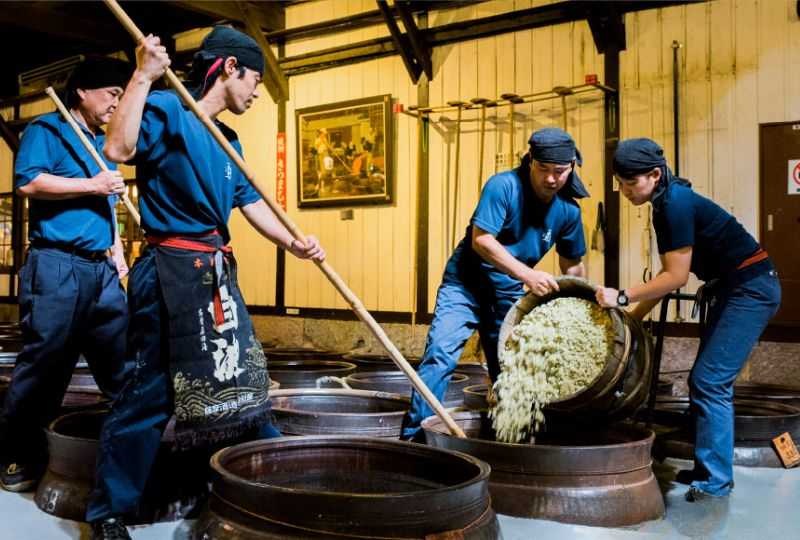
The creation of shochu Japanese involves a meticulous process that highlights the distiller’s craftsmanship:
Koji (麹 – Mold) Preparation: This is a crucial first step, unique to Japanese alcoholic beverages. Koji mold (Aspergillus oryzae) is cultivated on steamed rice, barley, or sweet potato. There are three main types of koji used for shochu:
- White Koji (白麹): Most common. Produces a soft, mellow flavor.
- Black Koji (黒麹): Used in many imo shochu and Awamori. Produces citric acid, which enhances flavor and prevents bacterial contamination, resulting in a richer, robust taste.
- Yellow Koji (黄麹): Less common in shochu (more in sake). Can yield a fruity, aromatic shochu but is harder to manage.
Primary Fermentation (一次仕込み – Ichiji Shikomi): Koji, water, and yeast are combined in a tank to create the koji moromi (primary mash). This process converts starches into sugars and then into alcohol.
Secondary Fermentation (二次仕込み – Niji Shikomi): The main ingredient (steamed sweet potato, barley, rice, etc.) is added to the primary mash. This mixture undergoes a longer secondary fermentation, converting more starches/sugars into alcohol, developing the unique flavors.
Distillation (蒸留 – Joryu): The fermented mash is then distilled.
- Single Distillation (単式蒸留 – Tanshikijoryu): Used for honkaku shochu. The mash is distilled only once in a pot still, preserving the delicate aromas and flavors of the base ingredient.
- Multiple Distillation (連続蒸留 – Renzokujoryu): Used for kōrui shochu. The mash is continuously distilled in a column still, yielding a highly purified, neutral spirit with minimal flavor and aroma.
Aging and Maturation (熟成 – Jukusei): After distillation, shochu is often aged in stainless steel tanks, ceramic pots, or oak barrels for several months to several years. Aging mellows the flavors and can add complexity.
Blending and Bottling (ブレンド・瓶詰 – Blend/Binzume): The master blender may combine different batches or aged shochu to achieve a consistent flavor profile before bottling.
5. How Shochu Differs from Other Spirits
While sometimes confused with “shochu Japanese wine” or compared to other global spirits, shochu Japanese possesses distinct characteristics that set it apart. Its unique production methods and focus on base ingredient flavors create a profile unlike its counterparts.
Here’s a comparison to highlight the key differences:
| Feature | Shochu (Honkaku) | Sake | Vodka | Whisky/Brandy | Soju (Korean) |
| Category | Distilled Spirit | Fermented Beverage (Rice Wine) | Distilled Spirit | Distilled Spirit | Distilled Spirit |
| Typical ABV | 20-45% (most commonly 25%) | 15-16% | 35-50%+ | 40-60%+ | 15-25% (often diluted) |
| Production | Single-distilled (Honkaku), uses Koji mold | Fermented (not distilled), uses Koji mold | Multiple-distilled, typically from grains/potatoes | Distilled, often aged in oak barrels | Often multi-distilled, various grains/starches |
| Base Ingredients | Rice, barley, sweet potato, brown sugar, buckwheat | Rice | Grains, potatoes | Grains (barley, corn, rye), grapes (brandy) | Rice, wheat, barley, sweet potato, tapioca |
| Flavor Profile | Retains distinct flavor/aroma of base ingredient; often clean, earthy, nutty, or subtly sweet | Fruity, savory, umami, rice notes | Neutral, odorless, tasteless (pure ethanol) | Complex, woody, smoky, fruity, caramel notes from aging | Often neutral, slightly sweet, sometimes artificial sweeteners added |
| Aging | Often aged in stainless steel/ceramic; some in oak for complexity | Typically consumed young; some aged for complexity | Rarely aged (unless flavored) | Essential for character development (oak barrels) | Less common, but some premium soju is aged |
| Key Differentiator | Unique Koji mold use & single distillation preserving base character | Fermented, not distilled | Extreme neutrality | Oak aging & complex flavor development | Often lower ABV, wider range of base ingredients |
The use of koji mold in shochu production is a defining characteristic, providing a unique fermentation environment (saccharification and citric acid production) that fundamentally differentiates it from most Western spirits. This process helps to unlock and enhance the unique flavors of its diverse base ingredients.
6. How to Drink and Serve Shochu
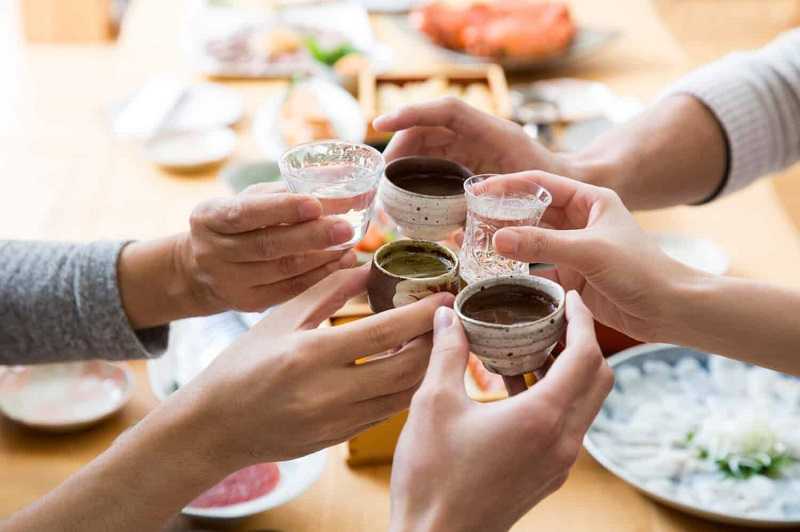
The versatility of shochu Japanese is truly one of its greatest appeals. There are numerous ways to enjoy it, catering to different preferences and occasions:
- Neat (ストレート – Straight): For connoisseurs, especially well-aged honkaku shochu. Allows you to fully appreciate the complex aromas and flavors of the base ingredient.
- On the Rocks (ロック – Roku): A popular choice. The ice slowly dilutes the shochu, mellowing its intensity and allowing different notes to emerge as it chills.
- Mizuwari (水割り – With Water): The most common way to drink shochu in Japan. Simply mix shochu with cold water, typically in a 6:4 or 5:5 ratio (shochu:water), but adjust to taste. This makes it lighter and easier to drink during meals.
- Oyuwari (お湯割り – With Hot Water): Especially popular in colder months and for imo shochu. Mix shochu with hot water (around 40-50°C / 104-122°F). Add hot water first, then shochu, to allow the aroma to rise. This brings out the sweetness and mellows the flavors, particularly in sweet potato shochu.
- Chuhai (チューハイ – Shochu Highball): A very popular mixed drink. Shochu mixed with soda water, fruit juice, or flavored carbonated beverages (e.g., lemon, grapefruit, ume). Kōrui shochu is often preferred for chuhai due to its neutral profile, allowing the mixer’s flavor to dominate.
- As a Cocktail Base: Its versatility makes it an excellent base for various cocktails, substituting vodka or gin for a Japanese twist.
7. Food Pairings with Shochu
Shochu Japanese is a fantastic companion to a wide range of Japanese and international cuisines, often enhancing the dining experience. Its ability to cleanse the palate and complement diverse flavors sets it apart.
- Imo Shochu: Its robust, earthy notes pair wonderfully with rich, oily dishes. Think grilled meats (yakitori, yakiniku), fried chicken (karaage), stewed pork belly (kakuni), or even strong cheeses. Its boldness stands up to hearty flavors.
- Mugi Shochu: Lighter and smoother, making it extremely versatile. It pairs well with lighter Japanese fare like tempura, sashimi, grilled fish (yakizakana), or mild stir-fries. It also works great with Italian cuisine or even light Western dishes.
- Kome Shochu: Clean and pure, it’s excellent with delicate dishes that don’t overpower its subtle flavors. Consider sushi, sashimi, fresh seafood, or light vegetable dishes.
- Kurozato Shochu: Its mellow sweetness and tropical hint complement grilled seafood, Okinawan cuisine, or even desserts.
- General Rule: Shochu typically pairs well with dishes that share similar flavor profiles or offer a delightful contrast. The “Oyuwari” style (with hot water) is particularly good with hot pots (nabe) or any comforting stewed dishes.
8. Unique and Creative Shochu Ideas
Beyond traditional serving methods, shochu Japanese offers a canvas for creativity:
- Shochu Cocktails: Experiment with shochu as a base for unique cocktails. Try a shochu sour with yuzu juice, a shochu mojito, or infuse it with fruits and herbs.
- Fruit-Infused Shochu (Shochu-zuke): Infuse honkaku shochu with fresh fruits like plum (umeshu), berries, or citrus for delightful homemade liqueurs.
- Shochu with Tea: Some enjoy mixing shochu with green tea (ocha-wari) or oolong tea, especially popular in izakayas.
- Aged Shochu: Look for koshu (aged shochu), which can develop incredible complexity, often stored in clay pots or oak barrels, offering notes similar to aged spirits.
>>> Read more: Sake And Famous Japanese Sake Brands You Should Know
9. Where To Buy Shochu
For those looking to explore the fascinating world of shochu Japanese, accessing a wide variety can be challenging outside of Japan. While some international liquor stores or Japanese specialty shops may carry a limited selection, a broader range is often available directly from Japan.
- Online Platforms: For international buyers seeking authentic and diverse shochu Japanese varieties, online shopping services that connect you directly to the Japanese market are invaluable. This allows you to find rare bottles, specific regional specialties, or new releases that might not be available locally.
- Janbox: A premier solution for international buyers. Janbox is an online proxy shopping and bidding service that allows you to purchase items from virtually any Japanese online store (including specialized liquor stores, e-commerce platforms like Rakuten or Amazon Japan, or even auction sites like Yahoo! Auctions Japan) and have them shipped directly to your location worldwide.
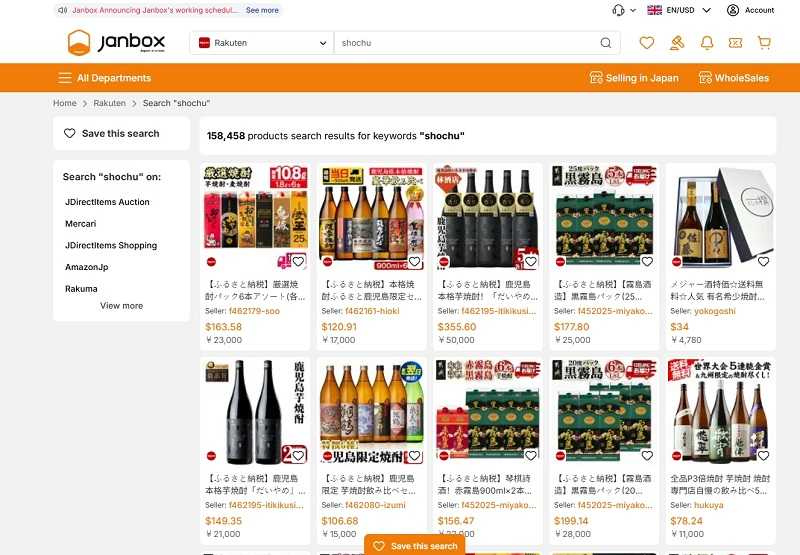
How Janbox helps:
- Access: Gain access to thousands of Japanese shochu varieties that are typically exclusive to the domestic market.
- Consolidation: Combine multiple shochu purchases (or other Japanese goods) into one shipment, optimizing international shipping costs.
- Support: Janbox handles the entire purchasing and international shipping process, including packaging and customs documentation, simplifying your buying experience.
Conclusion
Shochu Japanese, far from being a simple “Japanese wine,” is a highly versatile and culturally significant distilled spirit. Its rich history, diverse types (from earthy imo to smooth mugi), and intricate production methods offer a captivating journey for any beverage enthusiast. Whether enjoyed neat, on the rocks, with water, or in a creative cocktail, shochu promises a unique and rewarding experience.
Understanding shochu opens up a new dimension of Japanese gastronomy and drinking culture. With platforms like Janbox, accessing the vast selection of authentic shochu Japanese directly from its origin has never been easier. Embrace this multifaceted spirit and discover your new favorite drink.
Website: https://janbox.com
Email: [email protected]

